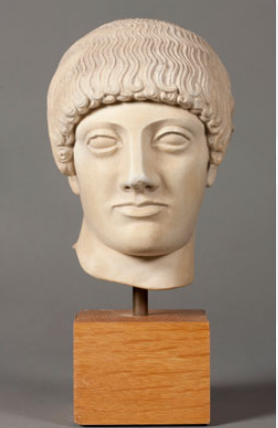
CC16: The Blonde Ephebe
The Blond Ephebe
Plaster cast, Ministry of Culture Casts and Reproductions, Greece, 1988
Purchased, 1996
Dimensions: H 25cm
Acc #: CC16, James Logie Memorial Collection
Copy of a marble head of a youth, c. 480 BC
Found at the Acropolis, Athens, 1923
Acropolis Museum, Athens, #: 689
Style
The Blond Ephebe is a male youth, represented slightly smaller than life-size. His head does not face the viewer directly, but is turned slightly to his right, giving the impression of a thoughtful or serious disposition. The turn of the head may be intended to balance the body in response to a contrapposto pose. He has a heavy cap of hair, which is plaited at the back. His somewhat stern expression is typical of the early Classical / Severe style to which this piece belongs.
History
The Blond Ephebe is thought to have been part of a full-sized dedicatory statue found at the Acropolis in Athens. It is possible that the statue was intentionally buried after the destruction of the Acropolis during the Persian invasion in 480 BC. The head and (possibly) the pelvis are the only parts of the Blond Ephebe to have been found, though the body was probably similar to that of the Kritios boy. Like the Kritios boy, the Blond Ephebe is typical of the early Classical / Severe style in his thoughtful expression and naturalistic features.
The statue is referred to as the Blond Ephebe because of remnants of yellow paint on the hair of the original statue. An ephebe is a young adolescent male, or more specifically in ancient Athens, a young man about to begin the traditional period of two years of military training.
The copyist has applied a light pink tint to the cast, possibly in imitation to the Greek custom of sculpture painting.
Further Reading
A short selection of references for this work includes:
- Greek Ministry of Culture. 1988. Catalogue of Casts and Reproductions. Athens: Archaeological Receipts Fund
- Lullies, Reinhard and Max Hirmer. 1957. Greek Sculpture. London: Thames and Hudson
- Payne, Humfry, and Gerard Mackworth-Young. 1950. Archaic Marble Sculpture from the Acropolis. London: The Cresset Press
- Ridgway, Brunile Sismondo. 1970. The Severe Style in Greek Sculpture. Princeton: University Press
- Stewart, Andrew. 2008. “The Persian and Carthaginian Invasions of 480 BCE. and the Beginning of the Classical Style: Part 1, The Stratigraphy, Chronology, and Significance of the Acropolis Deposits,” American Journal of Archaeology, 112, 377-412
- Whitley, James. 2001. The Archaeology of Ancient Greece. Cambridge: University Press

Side view of the Head of the Blond Ephebe

Front view of the Head of the Blond Ephebe

Reverse view of the Head of the Blond Ephebe